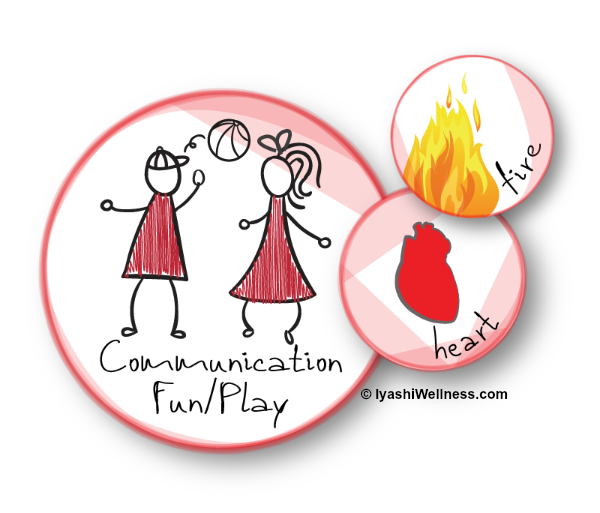
This is Pillar Two in our original series. Read the introduction here: 6 Pillars + Magic Stardust: The Secrets to a Wholesome, Happy, Healthy Child. Read about Pillar One, the Wood Pillar here. Read about Pillar Three: the Earth Pillar here
Today, we are discussing Pillar Two, the Fire Pillar.
When you think of children, it’s pretty universal to think of wide smiles and gleeful laughter. Children are the best teachers when it comes to helping us adults “be” in the present, slow down, and find the wonder and joy in the smallest of things. Children innately understand simple pleasures and revel in them, allowing these simple pleasures to take them to far off lands of wild imagination. Because of this openness and present-ness that children have, it also comes very natural for most children to quickly build deep friendships over shared interests. It may be a fleeting friendship at a park, but deep enough for the child to say “I made a new friend at the park today!” or a long-lasting friendship built over years of going to the same school or being part of a club. Children are ambassadors of joy and creativity and masters of human connection.
As I described in the previous Wood Pillar article, Chinese Medicine ascribes certain attributes to 5 natural elements: Wood, Fire, Earth, Metal and Water. In Chinese Medicine, human connection and the emotion of joy are attributes of the Fire Pillar, the same attributes of children described above. These examples illustrate a child balanced within the aspects of the Fire Pillar. When a child’s Fire element is in harmony with the rest of the pillars, the child can express joy and wonderment and connect with family and others in appropriate, balanced ways. When the Fire element is off balance, the line of appropriate expression skews, making children unable to self-regulate joyous emotions, making them prone to wild, manic expressions of joy with difficulty calming down, or the inability to stop certain activities at the expense of others because it provides joy or satisfaction. An unbalanced Fire Pillar can also cause behavior on the opposite end of the spectrum: a withdrawn, depressed and sad child.
When the Fire Pillar is off balance, these children also have a difficult time connecting with peers and family members, have difficulty making eye contact, maintaining sustained relationships, initiating social interactions, and reading social and emotional cues to interact appropriately. Interacting socially is a complex activity that requires layers of learned behavior through sociocultural input. It starts at home as the child watches and learns how his parents and siblings interact with one another and him. This input is enhanced at mommy and me classes and when they enter preschool or kindergarten and further on, learning from fellow friends and teachers what is appropriate and what is not. When cues are provided by family and society to a child, a child normally learns in time how to behave and interact appropriately. If, however, even after these natural cues are provided and the child still has socio-emotional developmental issues, in Chinese Medicine, we often look to the child’s Heart system.
Just as the Wood’s organ is the Liver in Chinese Medicine, the Fire’s organ is the Heart. By looking at signs and symptoms expressed by the child and assessing the child through palpatory diagnostic methods and inquiry, we can assess the strength of the child’s Heart system. We look for imbalances, such as emotional swings of depression or overjoy-mania, sleep issues, intimacy issues, cognition problems, speech impediments (stuttering, muttering, etc.), or pain/rash/redness/coldness along the heart channel (inner arm from the arm pit to the pinky finger). Then, through shonishin and/or acupuncture, herbs, diet, supplements and massage, physicians of Asian Medicine will bring that back to balance so that the Heart system can function properly.
In the case of a child, one of the fastest ways to see an imbalance in the Heart system is through his or her sleeping/napping abilities, emotional stability and looking at the eyes. Mothers often know right away just by looking at the eyes of their children that something is wrong or that they are sick. This is because even in Chinese Medicine, we say the eyes are the direct pathway into the soul of the being, and the Heart is the Monarch, Supreme Ruler in Chinese Medicine, in which all other systems must abide.
The Heart’s emotion is joy. When a child is blissfully happy, we know her Heart is balanced. When a child is depressed or angry, the Heart’s ability to control the rest of the systems are off balance. We also say if a child is too happy, i.e., manically happy, or is constantly seeking pleasure via the senses and can’t stop the activity, is also an imbalance of the Heart system.
How do you nurture the Fire Pillar in your child? You do so by helping a child see joy and gratitude in even the small things, as well as empathy towards others. Part of this, like with anything a child learns, is through role modeling from the parents. If a child sees a parent smiling and laughing often, it is contagious and a child will learn these cues. After all, a sense of humor is a cultural construct. Playing games, making jokes, playing card board games, making up stories, reading stories, drawing, playing pretend, and any of the myriad activities that promote imagination, creativity and positivity also help a child learn to tap into their joy. There are many actions a parent takes that children observe and that reinforce a sense of gratitude and expansion of the heart: hearing a parent say their thank you’s, taking a moment to appreciate a pretty stone during a walk, having a “Gratitude Talk” at the end of the night to say thanks for something in particular, thanking a child for their contribution in the family dynamic. A parent showing concern for self and others, bringing a child along to volunteer activities, and reaching out to help others teaches empathy. By building empathy, a child can learn that their actions can hurt – or uplift – another individual, and will then build the ability to regulate their emotions and actions to elicit – we hope – peace, harmony and community with friends and family members.
In regards to building a child’s sense of joy and humor, it must be noted that it requires you to provide the give and take of laughing and finding joy in the activity. This creates connection of the heart and spirit, filling the child with more positive Qi and a blueprint that to be human requires another human being to substantiate their existence and their sense in the world. It also creates what in the child development world is called Perspective Taking. As they develop, children grow beyond the “me thinking” toddler stage and eventually learn to do “we thinking.” Children who are on the spectrum often cannot do “we thinking” because their prefrontal cortex is lacking. The prefrontal cortex is what helps in decision making, self regulation, and impulse control. In Chinese Medicine, this same function falls under the Monarch, i.e., the Heart system’s function.
If your child is an introvert by nature, nurture empathy, perspective taking and laughter on a smaller scale, creating occasions of interactions with one friend at a time instead of in a group setting. If you as a parent are an extrovert, it is especially important to honor the child’s introvert nature and allow connection on a quiet, smaller scale. If you are an introvert and your child is an extrovert, this becomes a learning opportunity for both parent and child to foster self-awareness, knowing each other’s strengths, weaknesses and growth areas so that both of you can build empathy and a happy medium where you are nurtured and nourished in ways that will fulfill you both.
Though written for those in our profession by a fellow colleague, Suzy McCleary, DTCM, this article also elucidates other aspects of the Fire Pillar, the effects of overstimulation on the Fire Pillar, and additional tips to keep the Heart system calm and balanced.
Now that you are aware of the Fire Pillar and the influence it has on our lives, note where you can nurture it in yourself, your child, your family–with anyone you meet. I’m sure you’d agree that our world could do with more human connection and joy!
Next up, the Earth Pillar.
If you missed them, read the introduction to this series here: 6 Pillars + Magic Stardust: The Secrets to a Wholesome, Happy, Healthy Child. Read about Pillar One, the Wood Pillar here.
